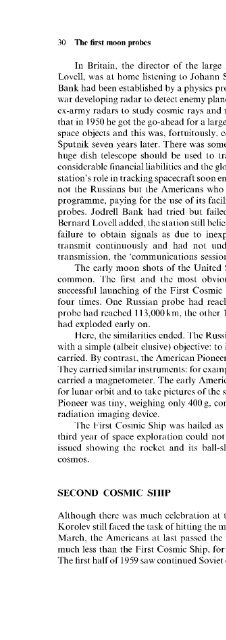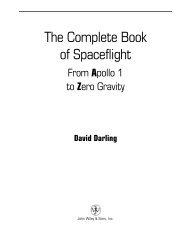Soviet and Russian Lunar Exploration
Soviet and Russian Lunar Exploration
Soviet and Russian Lunar Exploration
You also want an ePaper? Increase the reach of your titles
YUMPU automatically turns print PDFs into web optimized ePapers that Google loves.
In Britain, the director of the large radio telescope at Jodrell Bank, Bernard<br />
Lovell, was at home listening to Johann Sebastian Bach's Fantasy <strong>and</strong> fuge. Jodrell<br />
Bank had been established by a physics professor, Bernard Lovell, who had spent the<br />
war developing radar to detect enemy planes <strong>and</strong> ships. In peacetime, he now adapted<br />
ex-army radars to study cosmic rays <strong>and</strong> meteor trails. This work was so promising<br />
that in 1950 he got the go-ahead for a large radio telescope for radio mapping of deep<br />
space objects <strong>and</strong> this was, fortuitously, completed just in time for the launching of<br />
Sputnik seven years later. There was some debate in Jodrell Bank as to whether the<br />
huge dish telescope should be used to track spacecraft at all, but the station had<br />
considerable financial liabilities <strong>and</strong> the glow of world media publicity attached to the<br />
station's role in tracking spacecraft soon enabled that debt to be cleared. In fact, it was<br />
not the <strong>Russian</strong>s but the Americans who first brought Jodrell Bank into the moon<br />
programme, paying for the use of its facilities in 1958 for the early American moon<br />
probes. Jodrell Bank had tried but failed to pick up the First Cosmic Ship, but,<br />
Bernard Lovell added, the station still believed that the probe existed! He put down his<br />
failure to obtain signals as due to inexperience. He had imagined that it would<br />
transmit continuously <strong>and</strong> had not understood the <strong>Russian</strong> system of periodic<br />
transmission, the 'communications session' [6].<br />
The early moon shots of the United States <strong>and</strong> the <strong>Soviet</strong> Union had much in<br />
common. The first <strong>and</strong> the most obvious was their high failure rate. With the<br />
successful launching of the First Cosmic Ship, Russia <strong>and</strong> America had each tried<br />
four times. One <strong>Russian</strong> probe had reached but missed the moon. One American<br />
probe had reached 113,000 km, the other 102,000 km before falling back. All the rest<br />
had exploded early on.<br />
Here, the similarities ended. The <strong>Russian</strong> Ye-1 probe was large, weighing 156 kg,<br />
with a simple (albeit elusive) objective: to impact on the moon. Six instruments were<br />
carried. By contrast, the American Pioneer probes were tiny, between 6 kg <strong>and</strong> 39 kg.<br />
They carried similar instruments: for example, like the early <strong>Russian</strong> probes, Pioneer 1<br />
carried a magnetometer. The early American missions were more ambitious, aiming<br />
for lunar orbit <strong>and</strong> to take pictures of the surface of the moon. The camera system on<br />
Pioneer was tiny, weighing only 400 g, comprising a mirror <strong>and</strong> an infrared thermal<br />
radiation imaging device.<br />
The First Cosmic Ship was hailed as a great triumph in the <strong>Soviet</strong> Union. The<br />
third year of space exploration could not have opened more brightly. Stamps were<br />
issued showing the rocket <strong>and</strong> its ball-shaped cargo curving away into a distant<br />
cosmos.<br />
SECOND COSMIC SHIP<br />
Although there was much celebration at the achievement of the First Cosmic Ship,<br />
Korolev still faced the task of hitting the moon <strong>and</strong> doing so before the Americans. In<br />
March, the Americans at last passed the moon, but the accuracy of Pioneer 4 was<br />
much less than the First Cosmic Ship, for Pioneer 4 missed the moon by 60,015 km.<br />
The first half of 1959 saw continued <strong>Soviet</strong> difficulties with the R-7 launcher <strong>and</strong> a new







